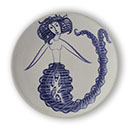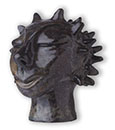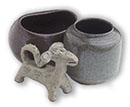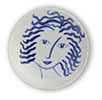|
|
|||||||||||||||||||||
They planned to live a simple life and set about fixing up the little farmhouse that was to be their home. Yet both realized almost from the start that farming might not fulfill their ambitions and in 1933 they returned to Denmark to explore training in some field of the arts. Kjeld spent six months helping a former schoolmate, Axel Bruhl, to build a kiln and picked up the rudiments of pottery making. Erica studied weaving during the same period. In the spring of 1934, the Deichmanns returned to Moss Glen and set up the pottery studio, later christened Dykelands after the small dykes on the property. The notes Kjeld make in Denmark were the basis for the first kiln they built. Despite the long stretch of time and distance that separated them from Denmark for most of their careers, the Deichmanns continually drew on the cultural resources of their heritage. Many of the characteristics which attracted people to their ceramics: the simplicity and elegance of the forms, surfaces and glazes, owe a debt to a Scandinavian sensibility that eventually had a profound effect on North American design and fashion in the late 1950s. Kjeld's forms, with their narrow necks and sinuous lines, and Erica's subtle glaze colours and elegant surface painting, were remarkably true to a style that can be described in the broadest sense as modern. The sensibility extended even to the ways in which Erica and Kjeld renovated their homes and set up their studios. The interiors featured white walls, unfinished wood, warm colours, portraits of ancestors and a Danish tapestry. Everything was done with an eye to presenting their work and living in sympathetic surroundings. The ambience of both the house and the rural setting lent a romantic appeal for visitors to Dykeland. The couple's pursuit of artistic expression through the medium of clay and the physical context in which they chose to do their work offered the public a chance to see craftspeople engaged in the creative process. The Deichmanns' wholesome lifestyle, peaceful rural life and close proximity to nature contrasted with the concept of technological progress that was dominant in their day. New BrunswickSoon after settling in, Erica and Kjeld, who had a lifelong passion for books, turned their collection into an informal lending library for neighbours. In this way, they began to make friends and acquaintances. Even more important to their lives were the contacts they made with the small circle of New Brunswick artists. These people included P.K. Page, Jack Humphrey, Miller Brittain, Ted and Rosemund Campbell, Pegi Nichol McLeod, Madge Smith and Kay Smith. The group often gathered at Moss Glen in the winters, providing friendship and the artistic stimulation that Erica and Kjeld treasured throughout their careers. Similarly, the Deichmanns were fortunate to have a group of patrons who shared their success and helped them through their failures. Although the Deichmanns encouraged the growing tide of tourists who "discovered" Dykelands every year, their fame became a mixed blessing. As early as 1945, Kjeld was talking about trying to escape. On the one hand, visitors from Saint John or tourists from the New England states became a major source of income through direct sales. On the other, the volume of visitors, especially in the summers, put considerable pressure on the social life of the family and hampered Erica's and Kjeld's research with clays and glazes. In 1956, the family moved to Sussex, New Brunswick. Canada and BeyondBy 1940, Deichmann ceramics had been included in exhibitions in New York, Paris and Glasgow, and Erica and Kjeld had begun to send their work regularly to shops and galleries outside New Brunswick. As their clientele grew to include people beyond their province, particularly from Ontario, Quebec and New England, offers to exhibit and demonstrate their work also increased. Through these trips, the Deichmanns took on the role of goodwill ambassadors. For example, they represented New Brunswick at the Saint Helen's Island Fair in Montreal in 1940, and Canada at the Rockefeller Center in New York in 1952. The Deichmanns were often asked to host visiting dignitaries and were very serious about their responsibility to their adopted country. In return, they were rewarded by a series of honours. Kjeld was invited to be among the first twelve people to receive Canadian citizenship at the first National Citizenship Ceremony in January 1947. The couple also produced an after dinner coffee service made for presentation by the City of Saint John to Princess Elizabeth and the Duke of Edinburgh during their visit in 1951. Kjeld received a Canada Council study and travel grant in 1960-1961, which enabled them both to travel and study again in Europe. Later, in 1987, Erica was awarded the Order of Canada. The ProductionFaced with both the need to survive through the selling of their work and their relentless determination to continually experiment and improve on previous work, the Deichmann Pottery's production took several directions simultaneously. There was always a need to produce small-scale domestic ware: the small jugs, mugs, plates, painted tiles and figurines that for most people satisfied a passing interest in ceramics. There was also pressure from customers to reproduce only the most fashionable forms and glaze colours. As with most creative people, the Deichmanns were often on the verge of a discovery in a new direction just as previous stage of their work caught on and created a demand. Their ability and willingness to compromise, to both create and respond to their market, was an important part of their professionalism. That so much of what the Deichmanns made has withstood a test of time and retains, fifty and sixty years after its manufacture, what some have called a "clarity" and "integrity", is witness to the success they achieved. Their genius lies in the way that they managed to express their values and experiences through what they created. Their intention was never to segregate beauty or meaning from everyday life, but rather to help people experience beauty in practical and useful objects. The Canadian Museum of Civilization holds over 160 of Erica and Kjeld's works of pottery, as well a significant holding of related photographic and print archival material. The work of the Deichmann's was celebrated at the CMC in the 1991-1992 exhibit, The Turning Point: The Deichmann Pottery, 1935-1963, which went on to tour across Canada. The Turning Point exhibition and catalogue and the Deichmann collection are based on the work of Dr. Stephen Inglis, Senior Curator, Canadian Museum of Civilization. |
Bibliography · Links · Credits · Index




















